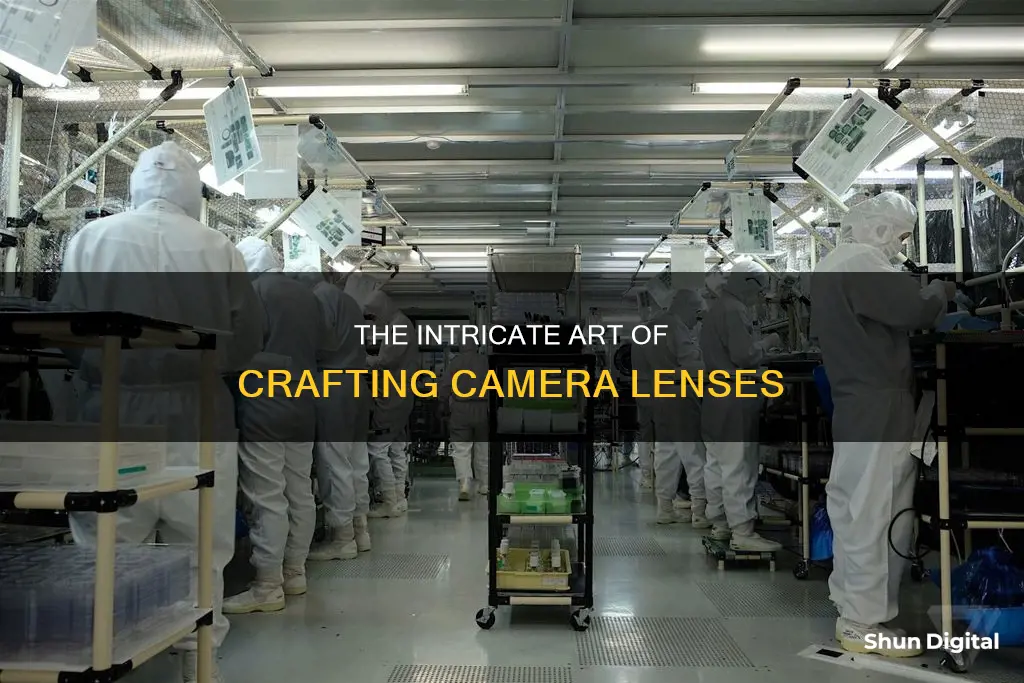
Camera lenses are intricate devices, and their production involves many steps and materials. The process of creating a lens begins with mixing and melting glass powder, which is then squeezed into a long glass strip. Small squares are cut from this strip, placed in a mould, and melted in an oven. The lens body is then assembled with the glass inside. This hands-on process requires precision and a careful design to ensure optimal performance. The glass shape is crucial as different waves of light react differently, and lenses need to be optimised to minimise aberrations. Modern lenses are complex, featuring autofocus motors, gears, and electrical components. The assembly must be done in a way that prevents dust from entering the lens and ensures weather resistance.
| Characteristics | Values |
|---|---|
| Materials | Glass powder, optical glass |
| Cost | $1000 per kilogram of optical glass |
| Process | Mix glass powder, melt into a liquid, squeeze into a long glass strip, cut into small squares, place in a mold, melt in an oven, assemble lens body |
| Cutting and Polishing | Individual glass lens elements are cut, shaped, and polished to precise specifications |
| Coating | Some lens elements require special coatings like Sigma's Super Multi-Layer Coating to reduce flare and ghosting |
| Edge Treatment | Edges of some elements are treated with special black ink |
| Motors | Modern autofocus lenses feature complex motors like Sigma's Hyper Sonic Motor (HSM) autofocus system |
| Gears and Cams | Used to control autofocus groups and zoom rings |
| Electrical Components | Required to enable coordination with different cameras |
| Weather Sealing | Many lenses have robust weather sealing to protect against adverse weather conditions |
What You'll Learn

Glass powder is mixed and melted to form a long strip
The process of making camera lenses is a complex and fascinating one. It involves a lot of different working parts and there is no simple way to create a lens. However, one of the most important steps in the process is when the glass powder is mixed and melted to form a long strip.
Firstly, optical glass is a complex blend of ingredients. Some representative ingredients include quartz or silicon dioxide (SiO2). The main ingredient in most recipes is quartz. Other ingredients may include an alkali flux to lower the melting point and stabilizers to increase corrosion resistance. For example, modern glass often uses sodium oxide, typically added as sodium carbonate (Na2CO3), and a tiny amount of potash (K2O), added as potassium carbonate (K2CO3). Lime (CaO) and magnesia (MgO) can also be added as stabilizers.
Once the ingredients have been blended thoroughly in a large mixer, the powder is melted into a liquid. This is done in a melting furnace, which uses a unique mechanism to gradually fill a crucible with molten glass. Small amounts of powder are added to a metal box on a mechanical arm, which flips and dumps the powder into the hot crucible. This process is repeated until the crucible is full and can take several hours.
After the powder has been fully melted, a worker melts a hole in the bottom of the crucible, allowing the molten glass to pour into a large water tank. This process creates "frit", tiny snowflake-like shards of glass. The frit is then mixed and blended to ensure it is completely homogenous. This is done in a cement mixer with a rubber liner to prevent contamination.
The frit is then ready for the final or fine melt. This step is very proprietary and involves the use of platinum-lined crucibles to prevent the glass from dissolving and changing its characteristics. The glass passes through three temperature zones to eliminate bubbles and ensure clear, defect-free glass. The glass is then cast into a ribbon of glass, which is gradually cooled and cut into strips.
The glass strips are then inspected for defects and measured for refractive index and light transmission. This step ensures that the glass meets the required specifications and standards.
The process of mixing and melting glass powder to form a long strip is a critical step in the creation of camera lenses. It involves a lot of precision and expertise to ensure the glass meets the required standards.
The Intricate Process of Camera Drone Manufacturing
You may want to see also

Small squares are cut and placed in a mould to be melted
Camera lenses are intricate devices, and their manufacturing process is a complex, hands-on endeavour. After the glass powder has been mixed and melted into a liquid glass, it is squeezed into long strips from which small squares are cut. These squares are then placed into a mould and melted once more in an oven. This step is critical, as it transforms the small squares into the precise shape required for the lens.
The squares are carefully measured and cut to ensure they fit perfectly within the mould. This process is repeated numerous times to create multiple identical lens components. Each lens typically requires over 100 individual parts, and the moulding process ensures that each piece is uniform and consistent.
The moulding process is a delicate operation, requiring precise control of temperature and pressure. The glass squares must be heated to a specific temperature range to ensure they melt evenly without compromising their optical properties. The mould itself is also meticulously designed to create the intricate curves and shapes necessary for optimal light refraction.
Once the squares are placed in the mould, they are heated in an oven until they reach a molten state. The temperature and duration of this heating process are carefully calibrated to prevent overheating, which could affect the glass's clarity and optical performance.
After melting, the glass undergoes a controlled cooling process to ensure its structural integrity. This stage is crucial, as improper cooling can lead to cracks or imperfections in the glass. The mould's design also facilitates this cooling process, ensuring the glass retains its desired shape as it solidifies.
Camera Battery Basics: Understanding Your Power Source
You may want to see also

Lens body is assembled with glass inside
Camera lenses are made of optical glass or plastic. They are designed to direct light to a camera sensor or film. The process of creating a lens body involves several steps, and one of the most crucial steps is assembling the lens body with the glass inside.
Firstly, glass powder is mixed in a large mixer and melted into a liquid state. This liquid glass is then squeezed into long glass strips, from which small squares are cut out. These squares are then placed in a mold and melted in an oven to form the glass pieces that will be used in the lens.
The next step is to assemble the lens body with the glass inside. This involves carefully positioning the glass pieces into the lens body and ensuring they are secured in place. The number of glass pieces and their arrangement will vary depending on the type of lens being created. For example, a simple lens may only require one piece of glass, while a zoom lens can have over 20 glass elements.
The lens body is designed to hold the glass pieces in place and allow them to move back and forth to change focus. It also accommodates the iris and other moving parts required for different lens functions. The lens body is typically made of metal or plastic and is designed to fit onto a camera body.
Assembling the lens body with the glass inside requires precision and expertise. The glass pieces must be positioned accurately to ensure optimal performance and image quality. This process is often done by hand, contributing to the high cost of lenses.
Once the glass is assembled inside the lens body, the lens is then calibrated and tested to ensure it meets the required standards for optical resolution, mechanical function, and auto-focus response. This includes testing the lens under varying temperature and environmental conditions and at different aperture settings and focal lengths.
Unleash Camera Raw: Bridge's Hidden Gem
You may want to see also

Lenses are coated and treated to ensure optimal performance
Camera lenses are coated to enhance their performance. The surfaces of camera lenses are covered in thin films called coatings, which play a crucial role in improving the lenses' performance. While ordinary glass lenses transmit most of the incident light, about 4% of light is lost due to surface reflection. As camera lenses typically have multiple elements, the cumulative effect of this light loss results in a significant reduction in the total amount of light transmitted through the lens.
Lens coatings are designed to address this issue by reducing surface reflection and increasing light transmission. By applying coatings to the lens surface, the reflected light from the coating surface and the lens surface can interfere with each other and cancel each other out, minimising the overall amount of reflected light. This phenomenon, known as light wave interference, is utilised to eliminate reflections.
The coatings are typically made of materials such as magnesium fluoride (MgF2) or silicon monoxide (SiO), and they are applied in very thin layers evenly over the lens surface using techniques like vacuum deposition or plasma sputtering. However, as light consists of various wavelengths, a single coating cannot eliminate all reflected light. To address this, multilayer coatings are used in high-end lenses, with some lenses featuring over ten layers of coating. These multilayer coatings have been shown to increase light transmission to 99.9% across a range of wavelengths, from ultraviolet to near-infrared light.
In addition to improving light transmission, lens coatings also help to reduce image-damaging flare and ghosting issues. Flare occurs when a strong light source causes white light to cover part or all of the lens, while ghosting refers to the creation of faint secondary images due to light reflecting between the front and rear surfaces of the lens. By reducing surface reflections, lens coatings minimise these unwanted effects, resulting in clearer and higher-quality images.
Furthermore, lens coatings can also be used for light filtering. For example, lenses that reflect ultraviolet light are commonly found in eyeglasses and sunglasses. Coatings can also be designed to allow the transmission of specific wavelengths of light, such as in video cameras, where lens coatings filter light into red, green, and blue wavelengths for image formation.
The latest advancements in lens coating technology include the development of subwavelength structure coating (SWC) by Canon. This technology utilises aluminium oxide (Al2O3) to create countless wedge-shaped nanostructures on the lens surface, providing a smooth transition between the refractive indexes of glass and air. This innovation effectively eliminates the boundary between different refractive indexes, further reducing reflected light and enhancing the performance of camera lenses.
Action Camera Batteries: Are They Interchangeable?
You may want to see also

Complex motors, gears, and electrical components are added
Camera lenses are intricate devices, and their production involves many complex steps. One of the most crucial aspects is the inclusion of advanced motors, gears, and electrical components, which elevate the functionality of these lenses.
Modern autofocus lenses, for instance, rely on complex motors to enable precise focusing. Sigma's lenses incorporate the Hyper Sonic Motor (HSM) autofocus system, which is renowned for its accuracy. These motors work in tandem with gears and cams to meticulously control autofocus groups and zoom rings. The intricate dance between these mechanical components ensures that photographers can swiftly and seamlessly adjust their focus, capturing crystal-clear images with ease.
The addition of gears and cams brings another layer of complexity to the lens-making process. These components must be meticulously crafted and calibrated to ensure smooth and precise control over the various lens functions. Each gear tooth and cam curve contributes to the overall precision of the lens, allowing photographers to make fine adjustments that can make or break the perfect shot.
Furthermore, electrical components play a pivotal role in the functionality of modern camera lenses. These components enable the lens to communicate and coordinate with a diverse array of camera bodies. The electrical systems within the lens help facilitate the transfer of data and instructions between the lens and the camera body, ensuring they work harmoniously. This integration of electrical components also expands the capabilities of the lens, allowing for features such as image stabilization and advanced autofocus algorithms.
The intricate marriage of optics and mechanics in camera lenses is a testament to the engineering prowess behind their creation. Each lens is a symphony of glass, metal, plastic, chips, and wires, carefully assembled to capture the world around us in stunning detail. The process of adding complex motors, gears, and electrical components is a pivotal step in this symphony, bringing camera lenses to life and empowering photographers to capture magical moments with precision and clarity.
Turn Off Burst Mode on Galaxy S8 Camera
You may want to see also
Frequently asked questions
Cutting and polishing individual glass lens elements is one of the earliest steps in making a camera lens.
In its most basic form, the process of creating a lens involves mixing glass powder, melting the powder into a liquid, squeezing it into a long glass strip, cutting small squares from the strip, placing the squares in a mold, melting them in an oven, and finally assembling the lens body with the glass inside.
Camera lenses are expensive due to the high cost of optical glass and the labor-intensive nature of the manufacturing process, which involves many complicated steps that require manual labor.







